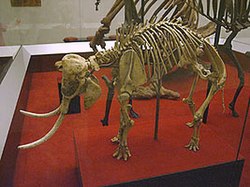Insular dwarfism

Insular dwarfism, a form of phyletic dwarfism,[1] is the process and condition of the reduction in size of large animals – typically mammals but also dinosaurs – when their population's gene pool is limited to a very small environment, primarily islands. This natural process is distinct from the intentional creation of dwarf breeds, called dwarfing.
This process has occurred many times throughout evolutionary history, with examples including dinosaurs, like Europasaurus, and modern animals such as elephants and their relatives.
There are several proposed explanations for the mechanism which produces such dwarfism, which are often considered likely to be co-contributing factors. One explanation is an evolved gene-encoded response to environmental stress. Another is a selective process where only smaller animals trapped on the island survive, as food declines to a borderline level. The smaller animals need fewer resources, and so are more likely to get past the break-point where population decline allows food sources to replenish enough for the survivors to flourish.
Examples
Among the most famous examples of insular dwarfism are:
- Dinosaurs, including the recently validated Europasaurus, on Mesozoic islands such as Haţeg Island, Romania. Other dwarf dinosaurs, mainly from Haţeg Island, include Magyarosaurus, Rhabdodon, Balaur bondoc and Telmatosaurus.[2][3] Also, the dwarf nodosaurid Struthiosaurus from Europe.
- Dwarf ground sloths in the recent natural history of Cuba, Hispaniola, and Puerto Rico. (There is also a living dwarf tree sloth on Isla Escudo de Veraguas.)
- The Channel Islands Mammoth which lived on the prehistoric island of Santa Rosae in the California Channel Islands, and the small woolly mammoths of Saint Paul Island off Alaska, and Wrangel Island north of Siberia.
- Dwarf elephants in the recent natural history of Malta, Crete, Cyprus, and Sicily.[4]
- Dwarf stegodons (elephant relatives) from the recent natural history of the Philippines, Flores, Sulawesi, Sumba and Timor.[5]
- A recently confirmed separate species of hominid called Homo floresiensis, from fossils found on Flores Island in Indonesia.[6]
- Small-bodied humans from Palau, Micronesia, similar in size to the Flores hominins (disputed).[7]
This process, and other "island genetics" artifacts, can occur not only on traditional islands, but also in other situations where an ecosystem is isolated from external resources and breeding. This can include caves, desert oases, and isolated valleys.
There is also an inverse process, island gigantism, wherein small animals breeding on isolated islands lacking the predators of large land masses may become much larger than normal. An excellent example is the dodo, the ancestors of which were normal-sized pigeons. There are also several species of giant rats, some extinct and some still extant, that coexisted with both Homo floresiensis and the dwarf stegodons on Flores.


Additional examples
- Bali Tiger †
- Channel Island fox in California, United States, and the enigmatic, nearly extinct Cozumel fox
- Cozumel Island Raccoon
- Honshū Wolf † in Japan
- Sardinian Dhole †
- Zanzibar Leopard, possibly extinct
- Key Deer of the Florida Keys
- Extinct Red Deer populations in Jersey[8]
- Philippine Sambar
- Candiacervus ropalophorus †, Crete
- Cervus astylodon †, Ryukyu Islands of Japan
- Hoplitomeryx †, the Gargano promontory (the former Gargano Island) of South Italy
- Philippine water buffalo, Tamaraw, anoa, the extinct Bubalus cebuensis † and other dwarf bovids from Southeast Asia
- The strange, tiny Balearic Islands Cave Goat (Myotragus balearicus) † in Majorca and Minorca and its close relative Nesogoral †, from Sardinia which became extinct after human settlement
- Several prehistoric species of dwarf hippopotamus † from the Pleistocene of Mediterranean islands (such as Hippopotamus minor) † and Madagascar
See also
References
- ^ Prothero, Donald R. (Winter 1982). "Allometry and Paleoecology of Medial Miocene Dwarf Rhinoceroses from the Texas Gulf Coastal Plain". Paleobiology. 8 (1): 16–30. JSTOR 2400564.
{{cite journal}}: Unknown parameter|coauthors=ignored (|author=suggested) (help) - ^ "Dwarf dinosaur island really did exist, scientists claim". Telegraph web site. Telegraph Media Group. 2010-02-22. Retrieved 2010-02-26.
{{cite web}}: External link in|work= - ^ Benton, M. J. (2010-01-28). "Dinosaurs and the island rule: The dwarfed dinosaurs from Haţeg Island" (PDF). Palaeogeography, Palaeoclimatology, Palaeoecology. 293 (3–4). Elsevier: 438–454. doi:10.1016/j.palaeo.2010.01.026. Retrieved 2010-02-26.
{{cite journal}}: External link in|journal=|coauthors=ignored (|author=suggested) (help) - ^ Extinct dwarf elephants from the Mediterranean islands
- ^ North American Extinctions v. World
- ^ Scientist to study Hobbit morphing, abc.net.au
- ^ "Ancient Small People on Palau Not Dwarfs, Study Says". National Geographic News. August 27, 2008.
- ^ Lister, A. M. (1989-11-30). "Rapid dwarfing of red deer on Jersey in the Last Interglacial". Nature. 342 (6249): 539–542. doi:10.1038/342539a0. PMID 2685610. Retrieved 2011-02-28.
